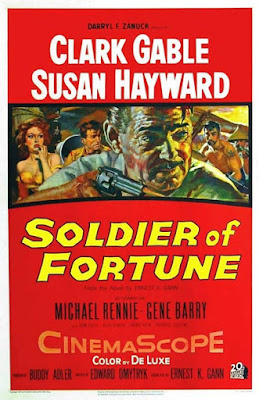
Always on the
hunt for older movies that we haven’t seen, we watched SOLDIER OF FORTUNE, a 1955
film starring Clark Gable and Susan Hayward. Gable has never been one of my top
favorites, but I’ve enjoyed just about every one of his movies I’ve seen. This
one is no exception. With a screenplay by Ernest K. Gann, based on one of his
novels, it’s a story of international intrigue set in Hong Kong. Hayward plays
a woman whose photojournalist husband (Gene Barry) has disappeared in mainland
China. She goes to Hong Kong to find someone who can locate her husband and
rescue him. Who better for that job than shady smuggler Hank Lee (Gable, of
course)? And, to the surprise of absolutely no one, Gable and Hayward fall in
love even though he’s the one trying to free her husband.
This movie is pretty predictable, and it sure could have used a little more action
(although the last half-hour is pretty darned good), but the fun lies in
watching Gable play the more-noble-than-he-wants-to-be rogue (nobody ever
played that part better), along with Hayward looking beautiful, a great
supporting cast including Michael Rennie as a British police inspector, Tom
Tully as a shady nightclub owner, Leo Gordon as one of his minions, and Richard
Loo as a former general brought low because he was on the wrong side when the
Communists took over in China. The movie looks good, and the musical score is
pretty good, too. Overall, SOLDIER OF FORTUNE isn’t in the top rank of Gable’s
films, by any means, but it’s a likable enough movie and I’m glad we watched
it.